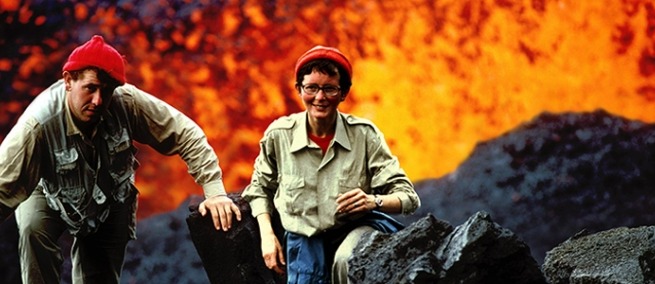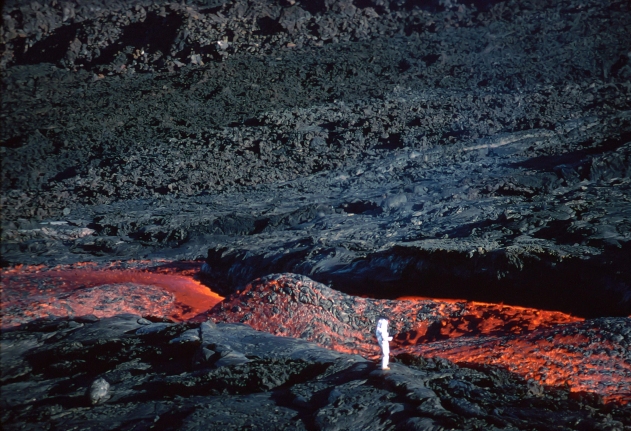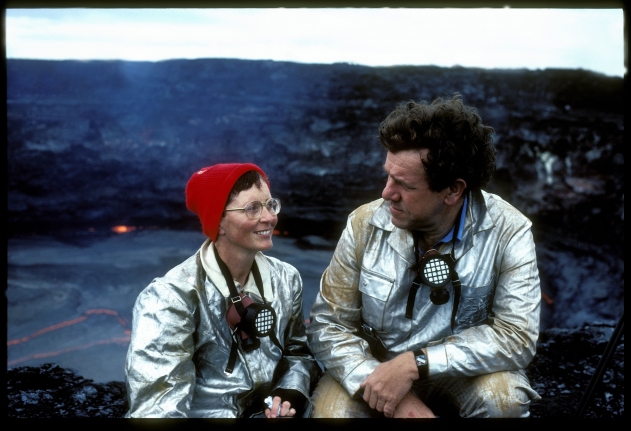
Clive Oppenheimer, Professor of Volcanology at the University of Cambridge, has been instrumental to a number of films with volcanos, most recently two that incorporate the archive of married volcanologists Maurice and Katia Krafft: Sara Dosa’s FIRE OF LOVE and Werner Herzog’s THE FIRE WITHIN: REQUIEM FOR KATIA AND MAURICE KRAFFT, which recently made its New York City premiere at DOC NYC. Oppenheimer met the Kraffts when he was beginning his career, before their death in a volcanic eruption in 1991 at Japan’s Mount Unzen. We spoke with Oppenheimer about the Kraffts’ work as scientists and filmmakers, and his pursuits in each realm.
Science & Film: What was your involvement with each of the new films about the Kraffts?
Clive Oppenheimer: I met Werner when he was shooting ENCOUNTERS AT THE END OF THE WORLD in Antarctica, 15 or 16 years ago. He filmed in our field camp at the top of a volcano called Erebus. Some years later, I got in touch with him because I’d been pitching a film about volcanos with not so much a scientific as an anthropological perspective: what do they mean to us? Werner liked that, so we ended up making INTO THE INFERNO together. We introduced the Kraffts in that film.
Before I pitched INTO THE INFERNO, I’d spent 12 years pitching with a producer in Bristol, Pete Lown, who said he’d like to do something about volcanos and I told him about the Kraffts and he was very excited, but it didn’t get any wings. He got back in touch with me when he’d moved companies, and he said maybe it’s got legs. We talked some more and refined the pitch, got some development funding, and he was keen to get Werner involved. I connected Pete and Werner, and Werner loved it and ran with it. So I was involved in conceiving the project [THE FIRE WITHIN].
Sara [Dosa] and I met at a scientist and filmmaker workshop four years ago now that was run by Sundance and the National Science Foundation. It was a wonderful encounter. We talked volcanos, I gave her a book on them, she went off to Iceland and made a film there where she got more volcanos and got more into it.
S&F: Why do you think the Kraffts are sparking so much interest right now?
CO: It's fascinating that two films about the Kraffts come out at the same time, but it’s not a coincidence I don’t think. There are some common threads. It’s 30 years since they were killed. What’s fascinating for me is it’s the same archive and you couldn’t get two more different filmmakers than Werner and Sara, and you get two completely different films with different feels and narrative arcs. It’s rekindling what the Kraffts did, which was to make films for the public, and there is a quality that their 16mm celluloid has that you don’t get with digital—despite the antiquity of the film footage, it’s remarkable stuff. And they knew what they were doing; they knew how to use a long lens to make it look like someone’s a lot closer than they are, they always put themselves in frame, and so it’s very dramatic, very poetic.
When I was a grad student, I met the Kraffts at my very first conference in Santa Fe. They left quite an impression. They showed one of their films, which I remember being very humorous. I remember talking to Maurice and he said, and I guess he said this all the time, but it stayed with me: “Clive, 95% of Frenchmen die in their beds, I would much rather die in a volcano.” When they were killed on Unzen it was a very turbulent time in volcanology. There had been another tragedy with scientists killed on Galeras in Colombia around then. Everyone knew the Kraffts were pushing it to get the footage they wanted—forty people were killed with them in an exclusion zone. It was quite a controversial scene. Japanese scientists were pretty unhappy about it. Then their footage was used in a film on volcanic hazards that was made under UNESCO patronage; it was being shown in communities around Mount Pinatubo in 1991 in the lead-up to that eruption. They died a matter of days before the eruption at Mount Pinatubo. So while there is a controversial side to the way they died and the people who died with them and followed them into the exclusion zone, their work had an impact in saving thousands of lives in the Philippines. That was a very significant legacy of theirs.

Copyright MAURICE & KATIA KRAFFT/DUMONT
S&F: Why were the Kraffts so interested in film, do you know?
CO: They followed on the heels of a guy called Haroun Tazieff. He was Polish but ended up in France. Tazieff was the real deal. He was the Cousteau of volcanoes; in the late 40s, 50, 60s [he produced] books, films, and I’ve been told that when one of his new films came out there would be lines outside the cinemas. So without Tazieff, I’m not sure you would have had the Kraffts. As well as doing all the popularization, Tazieff was [director of the volcanological laboratory at the Institut de Physique du Globe in Paris] where he opined on volcanic crises. Tazieff needs to be understood to understand where the Kraffts came from. I don’t know whether it’s an apocryphal story, but I remember somebody telling me that the Kraffts were on one of Tazieff’s expeditions and Maurice took out a film camera, and Tazieff banished them saying, I’m the one who does the filming.
In terms of what the Kraffts did, what comes across in both films [FIRE OF LOVE and THE FIRE WITHIN] is Maurice in particular was obsessive. Not only did he film, he bought and acquired everything—prints, books—about volcanos. I knew one of the executors of his will who described going through Maurice’s office in Paris and he was about to throw a letter in the bin and it was a letter from Emma Hamilton to Lord Nelson—she was the wife of William Hamilton, one of the first serious volcano observers in the 18th century. Maurice collected everything; he was nuts about volcanos. He taught and he wrote books to fund his obsession.
The Kraffts did what they did at the right time. They took advantage of being able to travel around the world and they could take great equipment and shoot in color. They realized how valuable it was to be able to go up in a plane and shoot from the air. I’d say increasingly into the late 80s up until when they died, they recognized how quickly you can access a region and when you have a big ash cloud in the sky it can be very difficult to get on the ground, but also being up in the air you get that synoptic scale. They realized that was a powerful thing. Now, people send drones in to get extraordinary footage of eruptions.
S&F: The worst thing that happens is the drone gets destroyed, I guess.
CO: The worst thing that happens is that somebody whose house is being consumed by lava goes viral on YouTube, which adds insult to injury. There is this intrusiveness to anyone sending a drone off and show somebody’s calamity and plaster it all over the internet.

1988, Katia and Maurice. Copyright MAURICE & Katia Krafft/DUMONT
S&F: What inspires your interest in film?
CO: The medium is so diverse now because it’s everything from YouTube, to documentary features. The conventional [film] in the phase of broadcast TV was 48 minutes with commercial breaks and cliffhangers. The more art end of it I dived into with Werner. When I’ve made films with Werner I haven’t set out to be pedagogic with them, I’m more interested in the art form, the visual language of cinema, but if on the back of that you’re inspiring people and somebody in the audience comes to you and says I see the world in a different way now, that’s the reward. So it’s less about education than putting something out there and hoping it inspires people. Of course, there are great materials on volcanos; it’s such a visual topic, auditory as well, multisensory, that it’s quite an easy sell to show something educational and link it to something that looks adventurous.
S&F: What are you focused on these days?
CO: I’m going to be in London tomorrow meeting with the production team that did INTO THE INFERNO and FIREBALL to throw around some ideas for the next movie. In volcanology, we’re still asking pretty much the same questions that proto volcanologists were asking 250 years ago: what makes volcanos work? Why do they erupt the way they do? We have a lot more in the kit now from synchrotrons and being able to look at the most nano-scale, to field equipment like spectrometers, drones, micro-sensing—a lot of tools for observation. My focus the past few years has been on writing a book which is cultural, historical, and personal perspectives on volcanos and so I’ve gotten into the history of the discipline. It’s been pandemic so it’s not been a great time for field work. Some of my missions got canceled and we’re still waiting to get back to North Korea, for example.
♦
FILMMAKERS
TOPICS